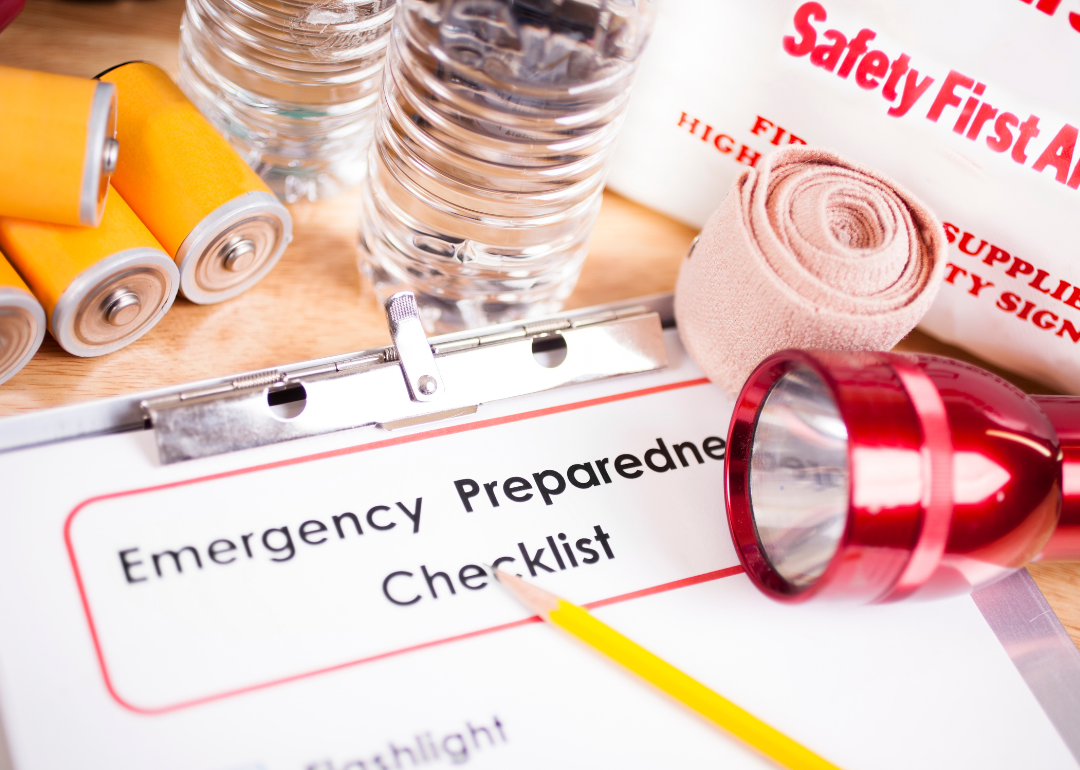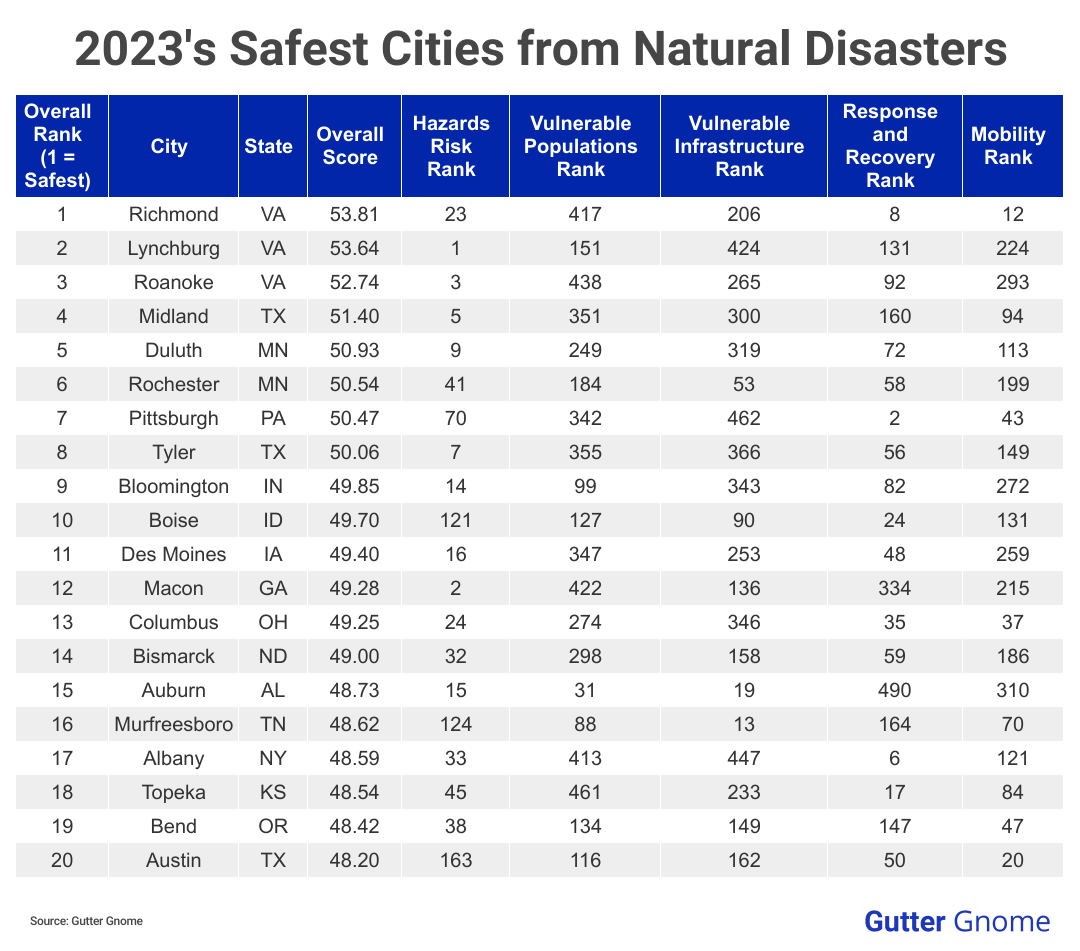
2023's top cities that are safest from natural disasters
2023's top cities that are safest from natural disasters
When Mother Nature reveals her unpredictable side, which cities are the most prepared to weather the storm?
As summer becomes fall and weather patterns become more unpredictable, Gutter Gnome identified 2023's safest cities with the least risk from natural disasters.
We compared the 500 biggest U.S. cities across five categories: hazards risk, vulnerable populations, vulnerable infrastructure, response and recovery, and mobility. Natural disasters include wildfires, earthquakes, tornadoes, hurricanes, and floods, among a total of 18 from FEMA's National Risk Index.
To find out if your city leads or lags in natural disaster safety, let's look at both the top 20 and a breakdown of how cities ranked according to various metrics. To learn how we ranked the cities, see our methodology at the end of the article.

Here are some key insights from our analysis
The big picture
Our ranking uncovered an interesting paradox: No top-ranked city excelled in all categories. Each displays a mix of strengths and vulnerabilities, highlighting the multifaceted nature of disaster preparedness. However, most of our top 20 cities have low hazard exposure — except Boise, Idaho (No. 10), Murfreesboro, Tennessee (No. 16), and Austin (No. 20), which offset their higher hazards risk with strong response and recovery and mobility.
The bottom 25 cities — predominantly in California — face a daunting reality: high hazard exposure (wildfires and earthquakes) combined with other widespread vulnerabilities. A few cities are making strides toward safety. However, it appears the majority of our worst-performing cities struggle to address the challenges posed by natural disasters.
Standout stats
Virginia is for preppers
- Virginia graces the top tier of our safest cities from natural disasters ranking. Three cities from this state — Richmond (No. 1), Lynchburg (No. 2), and Roanoke (No. 3) — confidently secured their places as our top 3, underscoring Virginia's inherent advantage: low exposure to natural hazards (between 1st and 23rd lowest in our hazards risk rank).
Lynchburg's safe haven
- Lynchburg, Virginia, holds a rock-solid position with the lowest natural hazards risk score, 44.13. Interestingly, Lynchburg's readiness for natural disasters is underwhelming at No. 131. Its intrinsic safety, however, means it doesn't need an elaborate response and recovery blueprint. One exception to its lack of natural hazards is the threat of powerful wind storms called derechos, but they occur an average of only 4 times every 100 years.
Miami's resilient response
- Miami (No. 49) brims with resources to manage natural threats (most notably hurricanes) — with top-5 scores across hospitals, fire stations, and urgent care clinics per square mile. This extensive preparedness means that, while Miami faces heightened hazardous risks (No. 490), it's unparalleled in its capacity to respond (No. 1).
Erie-ly good preparedness
- Erie, Pennsylvania (No. 29), ranks 5th worst in vulnerable infrastructure, with nearly 9 in 10 homes built before the 1980s. It also landed in the 32nd-worst place in vulnerable populations, with very high rates of people with a disability and without a car. However, the city's 9th-strongest response and recovery rank showcases its proactive preparedness. This proves that, despite significant vulnerabilities, Erie knows what it's doing to safeguard its residents.
The Big Apple's challenge
- Despite strong performances in mobility (No. 4) and response and recovery (No. 10), New York (No. 347 overall) faces unique challenges. It is the densest city, leading to the highest hazards risk (No. 500). Its high rate of residents without a car (close to 54%) contributed to its dismal vulnerable populations rank, No. 477. This underscores the need for NYC to lead in response and mobility to safeguard its inhabitants adequately.
Carson's silver lining
- Carson, California, landed at No. 485 in our ranking, making it one of the riskiest cities for natural disasters. However, it boasts a considerably less vulnerable population (No. 83). Carson has fewer elderly living alone, young children, and uninsured residents than most cities, a notable advantage to evacuation management.
Breaking down the metrics
To determine our rankings, our analysis of the 500 biggest U.S. cities considered several metrics, some of which are broken down below and show the five highest- or lowest-ranking cities for each metric.
Lowest natural hazards risk score
- Lynchburg, VA
- Macon, GA
- Roanoke, VA
- Warner Robins, GA
- Midland, TX
Highest natural hazards risk score
- South Gate, CA (TIE)
- Santa Monica, CA (TIE)
- Norwalk, CA (TIE)
- Los Angeles, CA (TIE)
- Carson, CA (TIE)
Lowest share of population aged 65+ living alone
- Perris, CA (TIE)
- Homestead, FL (TIE)
- Missouri City, TX (TIE)
- Pharr, TX (TIE)
- Edinburg, TX (TIE)
Highest share of population aged 65+ living alone
- Deerfield Beach, FL
- Southfield, MI
- Loveland, CO
- Largo, FL
- Santa Fe, NM
Lowest share of homes built before 1980
- Frisco, TX
- Buckeye, AZ
- Surprise, AZ
- Gilbert, AZ
- Goodyear, AZ
Highest share of homes built before 1980
- Flint, MI
- Cicero, IL
- Buffalo, NY
- Hammond, IN
- Detroit, MI
Most emergency medical technicians per 100,000 residents
- Nashua, NH
- Rochester, MN
- Peoria, IL
- Roanoke, VA
- Santa Maria, CA / Santa Barbara, CA (TIE)
Fewest emergency medical technicians per 100,000 residents
- Lincoln, NE
- Salinas, CA
- Santa Fe, NM
- Yakima, WA
- Bakersfield, CA
Most hospitals per square mile
- Miami, FL
- Cambridge, MA
- Allentown, PA
- San Francisco, CA
- Providence, RI
Fewest hospitals per square mile
- Auburn, AL (TIE)
- Pompano Beach, FL (TIE)
- Champaign, IL (TIE)
- Quincy, MA (TIE)
- St. George, UT (TIE)
Methodology behind the ranking
First, we determined the factors (metrics) that are most relevant to rank the safest cities from natural disasters. We then assigned a weight to each factor based on its importance and grouped those factors into five categories: hazards risk, vulnerable populations, vulnerable infrastructure, response and recovery, and mobility. The categories, factors, and their weights can be found here.
For each of the 500 biggest U.S. cities, we then gathered data on each factor from the sources listed.
Finally, we calculated scores (out of 100 points) for each city to determine its rank in each factor, each category, and overall. A city's overall score is the average of its scores across all factors and categories. The highest overall score ranked "safest" (No. 1) and the lowest "riskiest" (No. 500). Note: The "riskiest" among individual factors may not be No. 500 due to ties.
Final thoughts: Navigating to safety
Every September, the U.S. observes National Preparedness Month to remind Americans about the importance of emergency readiness. The goal? To drive home the critical message that readiness isn't just a reactive measure — it's also a proactive responsibility.
While natural disasters are unpredictable, they don't have to catch us off guard. Awareness and preparation can lessen the effects of disasters, ensuring your community's safety when the storm hits.
Here are additional measures you can take to strengthen your home's defenses against nature's forces:
- Review your insurance policy to ensure you have ample coverage, particularly for the types of disasters common in your region.
- Board up windows with sturdy plywood or storm shutters, especially if you live in a hurricane-vulnerable county.
- Secure or remove major appliances, like lawnmowers, grills, and air conditioning units, from the outdoors.
- Keep downspouts and gutters clean to prevent water damage.
- Shut off water and gas valves if you plan to evacuate and electrical valves when there's a flooding risk.
- Store flammable liquids like gasoline, propane, paint thinner, and alcohol safely.
This story was produced by Gutter Gnome and reviewed and distributed by Stacker Media.



